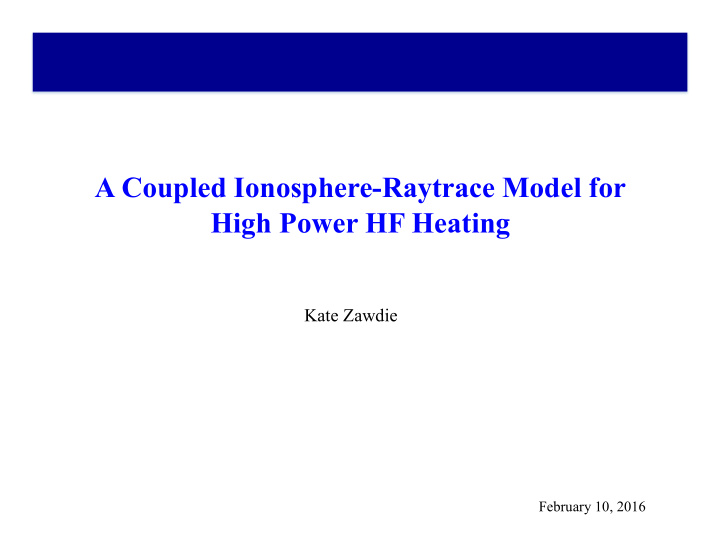



A Coupled Ionosphere-Raytrace Model for High Power HF Heating Kate Zawdie February 10, 2016
Does the HF Heating Location Change? • HF radio waves refract in the presence of horizontal electron density gradients • Observations from an Arecibo experiment indicate that the zonal neutral wind can change the location of HF heating
Ionosphere Model: SAMI3/ESF • photoionization • full chemistry (21 reactions and recombination) • ion inertia parallel to B • ExB drifts (vertical and longitudinal) • Solves the ion continuity, momentum and temperature equations (H + , He + , N + , O + , N 2 + , NO + , O 2 + ) • nonorthogonal, nonuniform fixed grid • Solves the electron momentum and • 3D, but limited to 4° longitude (4 km temperature equations longitudinal resolution)
HF Heating Model in SAMI3 • Electron Temperature Equation ∂ T e ∂ t − 2 1 ∂ T e 2 ∂ n e k b s ∂ s = Q en + Q ei + Q phe + Q source ∂ s κ e 3 • Source Term ⎛ ⎞ Q source = dT e 2 / Δ z 2 2 / Δ θ 2 2 / Δ ϕ 2 [ ] exp − θ − θ 0 [ ] exp − ϕ − ϕ 0 [ ] ( ) ( ) ( ) exp − z − z 0 ⎜ ⎟ dt ⎝ ⎠ 0
Density Depletion Drifts with the Zonal Wind
SAMI’s got MoJo 1. SAMI3 calculates the electron density (including HF heating) from first principles 2. MoJo uses the electron density to determine the new path of the heater beam 3. SAMI3 uses the HF propagation path to determine a new location for HF heating ω = ω p ω 2 = ω p 2 + ω ecf 2
The Snapback Effect: Observations and Simulations Simulation with 60 m/s zonal wind
Original Snapback Theory 60 m/s zonal wind
Physical Mechanism for Snapback Effect 60 m/s zonal wind
Effect of Zonal Wind Speed on Heating Location
Effect of Heating Rate/Frequency on Heating Location
Summary • The location of HF heating can change as a function of time • The coupled model successfully simulates the result of the 1988 Bernhardt experiment • The heating region snaps back, not the ray as originally expected • The frequency of snapback increases as a function of zonal wind speed • To suppress the snapback effect one can lower the heating rate and/or the heating frequency
Recommend
More recommend